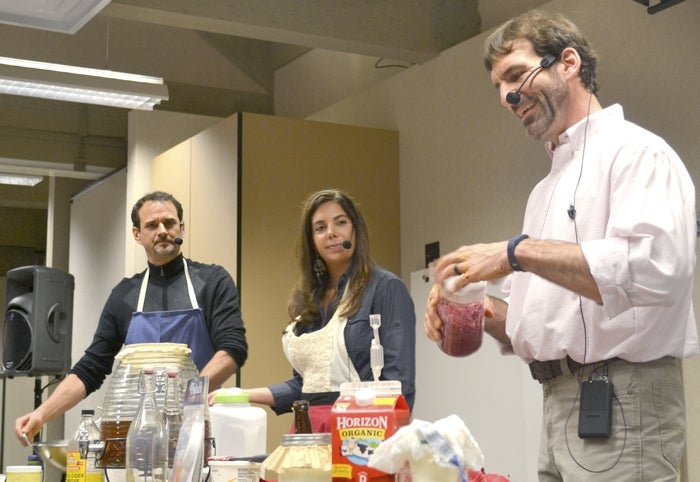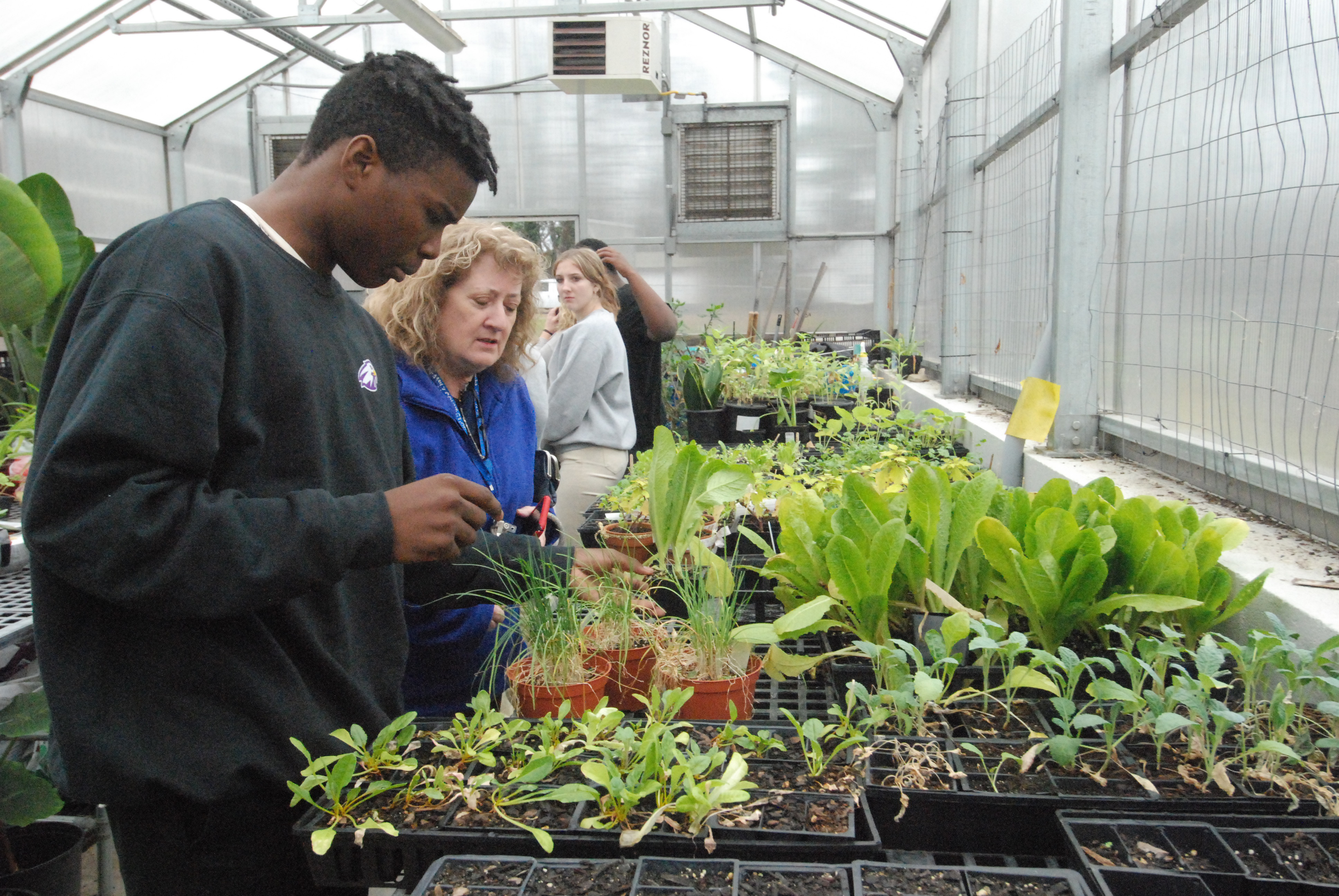The right foods can heal what ails you
Published 12:06 am Tuesday, March 24, 2015

- Rebecca Rider/Center for the Environment From left, Dr. Chris Magryta, Nicole Magryta and Dr. Chris Nagy show and tell about food that will improve health at Catawba College's Center for the Environment.
By Rebecca Rider
For the Salisbury Post
Every illness can be traced back to diet, said Dr. Chris Magryta at “The Healing Arts of Food,” presented at the Center for the Environment at Catawba College last week.
Specifically, the health of the body depends on the health of the gut. The intestines are the body’s interface with the world, Magryta explained. It’s where nutrients are absorbed and are used to strengthen the body and the immune system. Problems arise when it’s not being fed properly. Panel speakers discussing how food and health intertwine included Chris Magryta, Nicole Magryta and Dr. Christopher Nagy.
Chris Magryta is a physician with Salisbury Pediatrics who focuses on integrative medicine and pediatric allergies. Nagy is an orthopedic surgeon and practitioner of Age Management/Regenerative Medicine. Nicole Magryta is a clinical nutritionist at Salisbury Pediatrics.
“It all starts in your gut,” Nicole Magryta said. “We are only as healthy as what we put in it.”
Chris Magryta and Nagy note that there’s been a rise in what they call Leaky Gut Syndrome — where the intestinal lining breaks down and foreign particles find their way into the gaps. This results in inflammation and food allergies. Panelists hoped to cure and prevent cases of leaky gut by showing audience members how to cook foods that are gut-healthy and natural anti-inflammatory.
“These foods are all healing,” Nicole Magryta said. “They all address that problem.”
Many of the recipes are old country remedies: bone broth and sauerkraut and kombucha, which have been used to maintain health for thousands of years.
“This is kind of new stuff,” Nagy said. “Though historically it’s what our great-grandparents did, it’s new to us.”
Nicole Magryta started the evening by walking the audience through making bone broth. Bone broth has been a go-to treatment for generations; the boiling process leeches the marrow from the bones, resulting in a highly nutritious soup base that has anti-inflammatory properties. Traditional bone broth can be made from any kind of meat—chicken, beef, fish. All that’s required is a pot of boiling water and the bones of choice. You can spice things up, she said, by adding vegetables and some seasoning.
Nicole Magryta recommends using bones from organic, grass-fed meat. Toxins that the animal has ingested in its life will accumulate in the fat, which finds its way into the broth. And while traditional bone broth can be boiled for up to 24 hours, if you’re sensitive to MSG it’s better to boil bones for only two to three hours, she said.
Next, Nagy discussed the importance of a diet containing fermented foods. Our gut is a natural greenhouse for bacteria, Nagy said. In a healthy human, these bacteria are beneficial, help with digestion and act as the starting point for our immune system.
If you consider all the DNA in your body, including the DNA of the bacteria making up your flora, it would be more like “10 percent you and 90 percent bacteria,” Nagy said.
But if we don’t maintain a proper diet, the good bacteria start to die off and are replaced by bad bacteria. To fix this imbalance, it’s important to eat foods that contain lots of natural good bacteria, or pro-biotics. While you can get pro-biotics from supplements, Nagy said, the cheapest way is to eat fermented foods.
“Every culture pretty much has a fermented food,” he said.
To give attendees an idea of which foods they could add to their meal plans, Nagy walked through the making kefir, sauerkraut and kombucha, a fermented tea. Kefir and kombucha both require an initial culture that must be purchased or obtained from a friend — much like friendship bread.
Kefir is a form of fermented milk that originated in Russia and Kazakhstan. It’s much more beneficial than store-bought yogurt, which can contain as much as 8 1/2 teaspoons of sugar per serving. Kefir packs a pro-biotic punch and doesn’t contain the sugar — and it’s relatively easy to make. Place the culture, known as “kefir grains,” into a jar with some whole milk and leave it on a counter or in the cupboard — it doesn’t need to be refrigerated.
Kefir typically takes 18-24 hours to ferment. When it’s done, strain out the grains and drink the result — or use it to make smoothies. The grains can then be reused to make more kefir. It’s good to be quick though; the culture will die if it’s not fed regularly. You can even make flavored kefir with fruit or flavored yogurt — the sugar will feed the fermentation instead of sneaking into your bloodstream.
Sauerkraut is easy to make, as well, and much more beneficial than the store-bought variety, which is often dead, pro-biotically speaking. Take some chopped red cabbage, garlic, turmeric, and ginger, and mix—or “squish,” Nagy said—it all together with some salt and pack it into a jar. Cover with some cabbage leaves, seal it, and let it stand for five-to-20 days. Be sure to pack it well, and to either off-gas it manually every twelve hours or buy an off-gas lid—Nagy recommends the Perfect Pickler. You can add a culture to the sauerkraut or let it ferment naturally.
Next, Chris Magryta demonstrated how to make ghee. Ghee is clarified butter, meaning that all of the milk protein has been removed. It’s the milk protein that often irritates the gut and causes inflammation and conditions such as lactose intolerance. But ghee has great anti-inflammatory properties and also coats the lining of the gut and provides a protective barrier, allowing it to heal.
In between demonstrations, panelists answered questions, dispensing dietary advice and resources for attendees. Nicole Magryta said that instead of avoiding fats altogether, it’s important to learn which fats are good for you and which are not.
“We live in a fat-phobic society,” she said.
But fat plays an important role in health. She said that good fats are those found naturally in nuts, avocados and wild-caught salmon. When cooking, avoid canola and vegetable oils, and use coconut oil, olive oil, and lard instead — all three contain fats to make the body healthy. And avoid anything with trans fat, she said.
Panelists said that other gut-healing foods include vegetable fiber and turmeric, which is a natural anti-inflammatory substance.
Changing your diet and making sure you have a healthy gut are the keys to well being, panelists said. In the medical community there is little conversation about root causes of diseases, Chris Magryta said.
Nagy noted that in today’s society, there is often a focus on addressing symptoms with pills. You need to address the root cause, he said; otherwise it’s just killing you in the long run. These three believe you should start with food. If you suspect something is bothering you, it’s the easiest thing you can fix.
“You don’t need a lab test,” Chris Magryta said. “Just stop eating the food and see what happens.”
Eat properly, control stress, get proper sleep and exercise, and health becomes a lot more manageable —i t can heal ongoing medical issues and stop problems before they start.
“To fix the body, fix the diet,” Nagy said.
Here are some books the panel suggested:
“The Wahls Protocol: A Radical New Way to Treat All Chronic Autoimmune Conditions Using Paleo Principles,” by Terry Wahls and Eve Adamson
“The Inside Tract: Your Good Gut Guide to Great Digestive Health,” by Gerard E. Mullin
“The Autoimmune Solution: Prevent and Reverse the Full Spectrum of Inflammatory Symptoms and Diseases,” by Amy Myers M.D.
“The Art of Fermentation: An In-Depth Exploration of Essential Concepts and Processes from around the World,” by Sandor Katz
“Nourishing Traditions: The Cookbook that Challenges Politically Correct Nutrition and the Diet Dictocrats,” by Sally Fallon
The Center for the Environment was founded in 1996 to educate the college community and the public about environmental stewardship and sustainability, provide value-added education for students through interaction with thought leaders and opportunities for experiential learning, and bring diverse people and groups together to catalyze sustainable solutions to our most persistent environmental challenges. For more information, visit www.CenterForTheEnvironment.org or www.CampaignForCleanAir.org.






